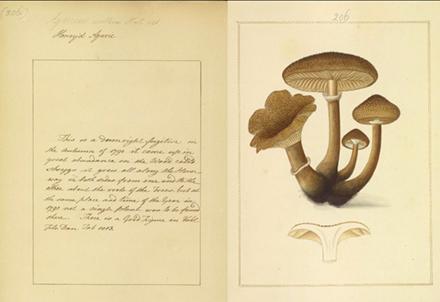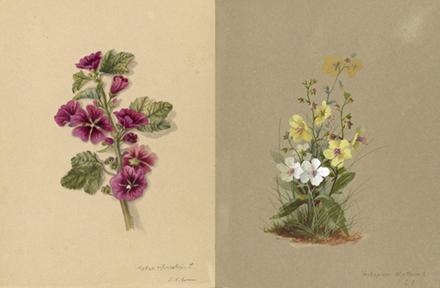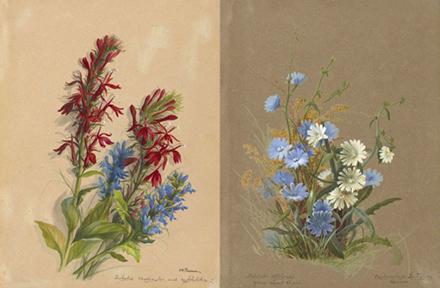The Art in Science

Icons Fungorum circa Halifax Sponte Nascentium, Honey’d Agaric
Special Collections at the National Agricultural Library (NAL) houses thousands of treasures that are historical, one of a kind, and irreplaceable. Preserving these rare books, photographs, and manuscripts is a priority, as is providing access to them. Many of the materials are primary resources used for scientific and academic work and include beautiful images. Embodying the artistry and scientific discovery of an earlier age, James Bolton’s Icons Fungorum circa Halifax Sponte Nascentium (1784-1792) and Deborah Griscom Passmore’s Wildflowers of America (ca. 1911) were recently digitized. Now, everyone has access to these gems online, while the manuscripts are preserved in an environmentally controlled, secure space.
James Bolton (1735-1799), a British self-taught naturalist and artist, was best known for A History of Fungesses [sic] Growing about Halifax (1788-1791). The four-volume published work documents hundreds of fungus species. The volumes established Bolton’s place in mycology and became a standard for mushroom identification in the field. It was based on Icons Fungorum circa Halifax Sponte Nascentium. Containing hundreds of detailed watercolor plates of fungi as well as descriptive notes, the six-volume manuscript began 4 years before the published work and finished 1 year after it. Three of the plates preserve actual specimens of fungi. These fungi are the only Bolton specimens known to have survived outside the United Kingdom.

Wildflowers of America, Malva and Verbascum
Moving to the 20th century manuscript, Deborah Griscom Passmore (1840-1911), a professionally trained artist and teacher, worked at USDA’s Division of Pomology for 19 years. Becoming leader of the staff artists in her first year, she was a prolific artist, painting thousands of watercolors. Many of her watercolors are available through the USDA Pomological Watercolor Collection for high-resolution download. In addition to her work at USDA, Passmore continued to paint in her personal time. Proof of that effort is in her unpublished work Wildflowers of America. After her death, it was bound into an album and contains original watercolors and sketches. The artist signed many of the works, and Edward Lee Greene, a well-known botanist, provided scientific names of the varieties. NAL acquired the manuscript in 1924.

Wildflowers of America, Lobelia and Cichorium
Now, in the 21st century, these manuscripts are available online thanks to the work of NAL's Digitization Unit. Library technician Kelvin Posey digitized both manuscripts and described the unique challenges they presented. He employed a two-camera book cradle system to capture most pages of the Bolton volumes because they were bound together. However, he had to use an overhead camera system for those pages with plant specimens to avoid damaging the samples. The Passmore album was bound with warped pages, so Kelvin used the overhead camera with a vacuum table to gently straighten the warped pages. In the end, Kelvin noted, “It gratifies me to imagine someone appreciating the works without needing to know what it took to digitize them.”
For more information regarding these treasures or any of our other holdings, contact NALSpecialCollections@usda.gov - By Special Collections and Digitization Unit, National Agricultural Library.
You May Also Like

